10 Cuddling Positions to Try (+ 7 Unexpected Benefits)
Updated: December 1, 2025 | Published: February 6, 2025Whether with your partner, kids, pets, or just your pillow, cuddling is a soothing and relaxing act that produces all the feel-good hormones in our brain, especially oxytocin, often called the “love hormone.”
Cuddling isn’t just something humans do. Other mammals such as dogs, monkeys, and lions also love cuddling their mating companions and babies. It’s an easy way for us to show affection to our loved ones.
Cuddling also boasts many health and relational benefits. It makes us feel safe, secure, and close to our cuddle partners, strengthening bonds and creating trust.
In this article, we will explore the best connection-building cuddle positions to test out with your partner. When you know how to cuddle, you can fully enjoy its benefits in the most comfortable way possible.
Best Cuddling Positions
1. Spooning
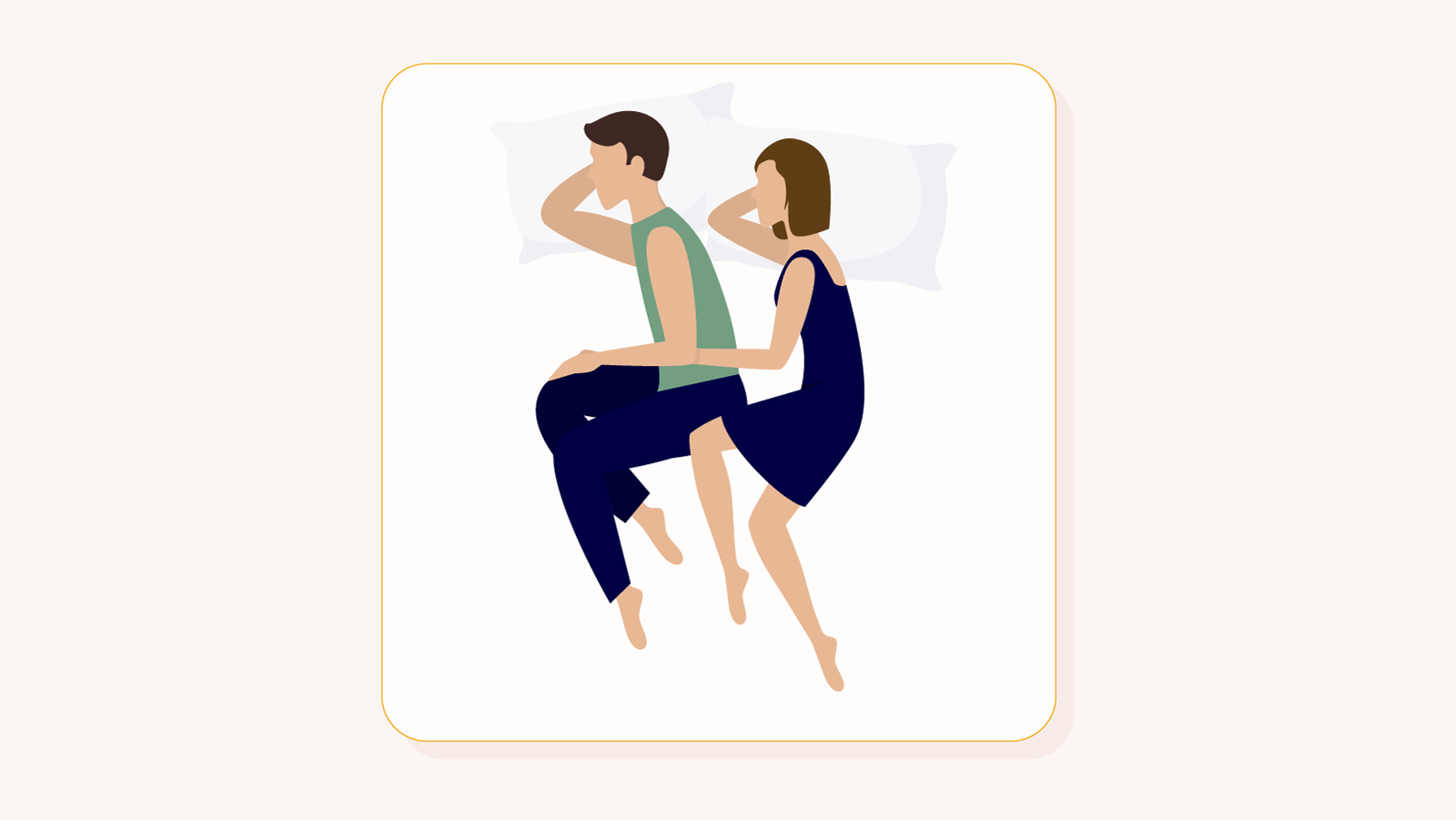
For spooning, one partner takes a “protective” stance by being the big spoon (i.e., holding the other partner from the back).
To carry out this position, lie on your side with a partner, with both of you facing the same way. One of you should face the other’s back. The partner in the front position (the “little spoon”) nestles their back into their partner, while the “big spoon” wraps their arms around the other.
This is a common cuddling position since many adults sleep on their sides. It’s also one of the positions that provides the most warmth. This is ideal for cold nights, or if you sleep cool and need to steal your partner’s warmth.
Cuddling comfort tips:
- It’s easier to cuddle if the taller partner assumes the “big spoon” position.
- If you’re the big spoon, prevent arm numbness by placing your arm under your partner’s pillow or neck instead of below their body.
- For extra back support as the big spoon, you can also have a pillow lying against your back.
2. Half-Spoon
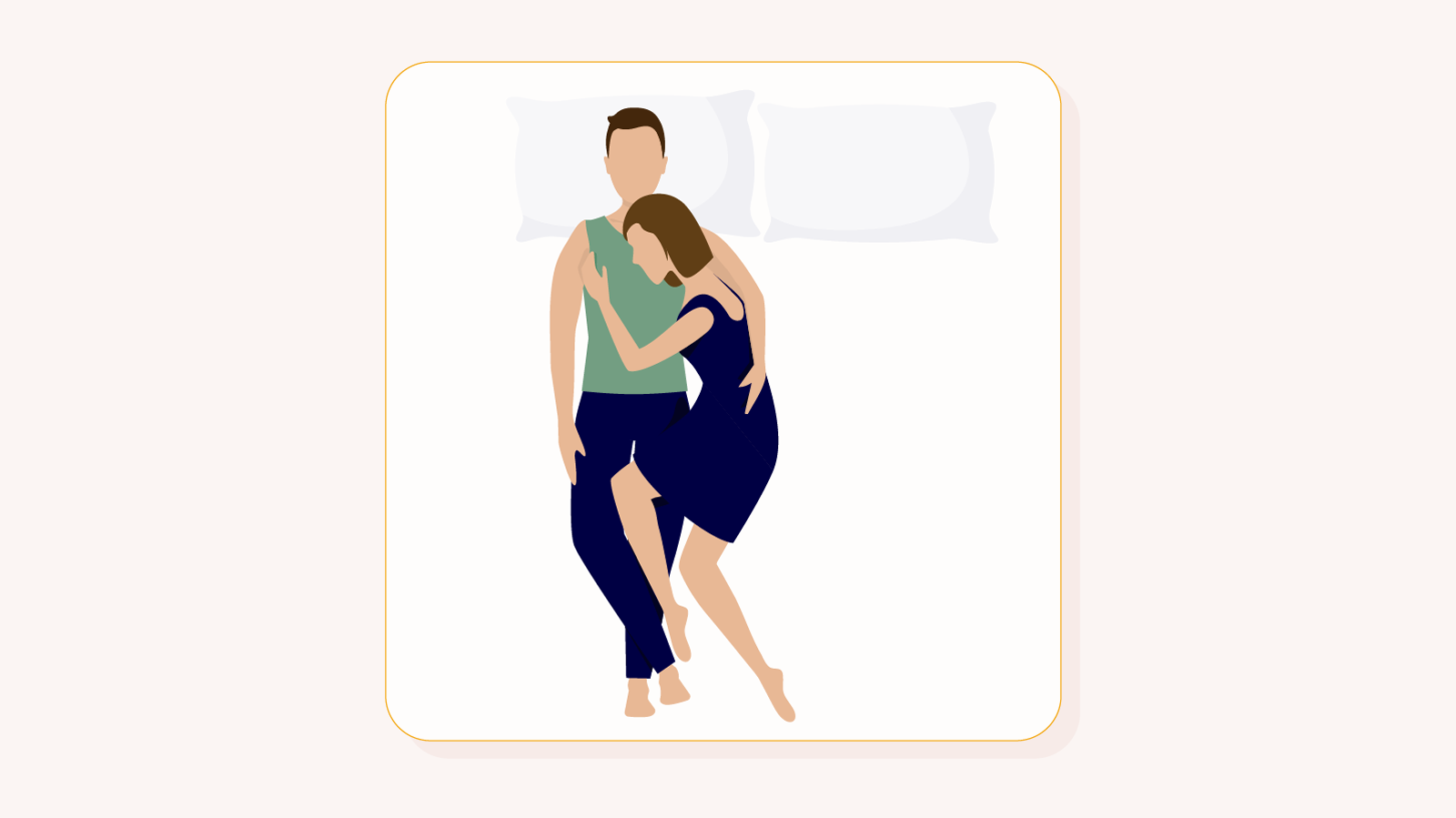
For this position, one partner lies on their back. The other partner lies on their side and rests their head on their partner’s chest or in the neck crook. The side-lying person uses their partner’s arm as a pillow. The one lying on their back can hug their partner, either with one hand on their back or with both hands.
Cuddling comfort tips:
- Make this position feel even more intimate by intertwining your legs with your partner’s.
- As the top-lying partner, get more pressure and warmth by resting more of your upper body on your partner. You can go as far as laying most of your stomach on top of your partner’s torso.
- Make sure the pillows where you’re resting your heads are close together. That way, the person lying on their back has good arm support while under their partner.
3. Face-to-Face
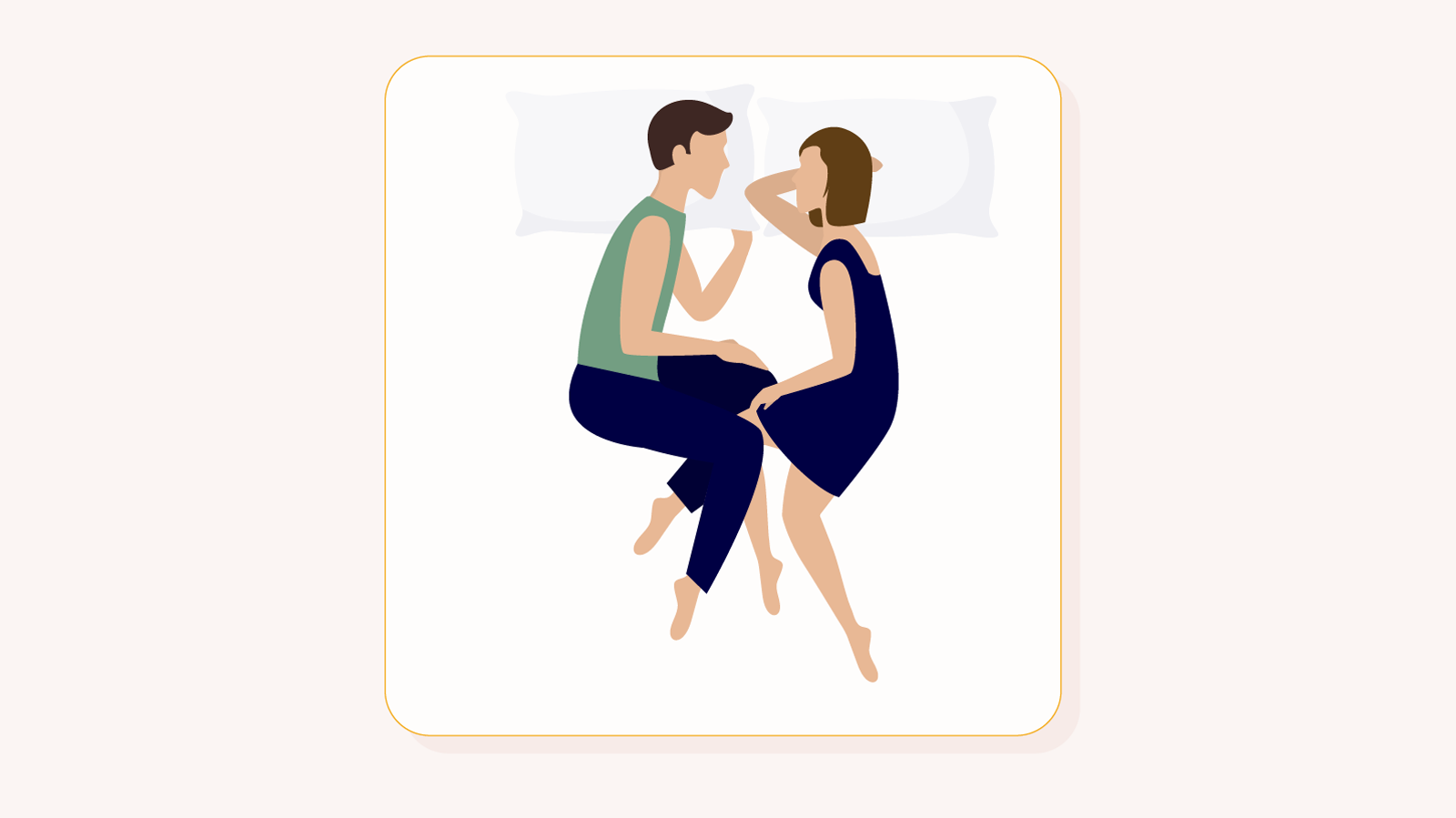
Also known as the “honeymoon” cradle, this position requires both partners to lie on their sides and face each other.
There are many positions where you can be face-to-face with your partner, so finding the right one is the key to making it more comfortable. You can be close together, have space between your bodies, or lie on your stomachs while facing each other. Try out different positions to find the right one for you.
Cuddling comfort tips:
- If you want to be close to your partner without being entangled, you can intertwine your legs and drape your arms loosely around each other.
- Get even closer by hugging each other more tightly so your bodies are flush against each other and your heads lean together.
4. Back-to-Back
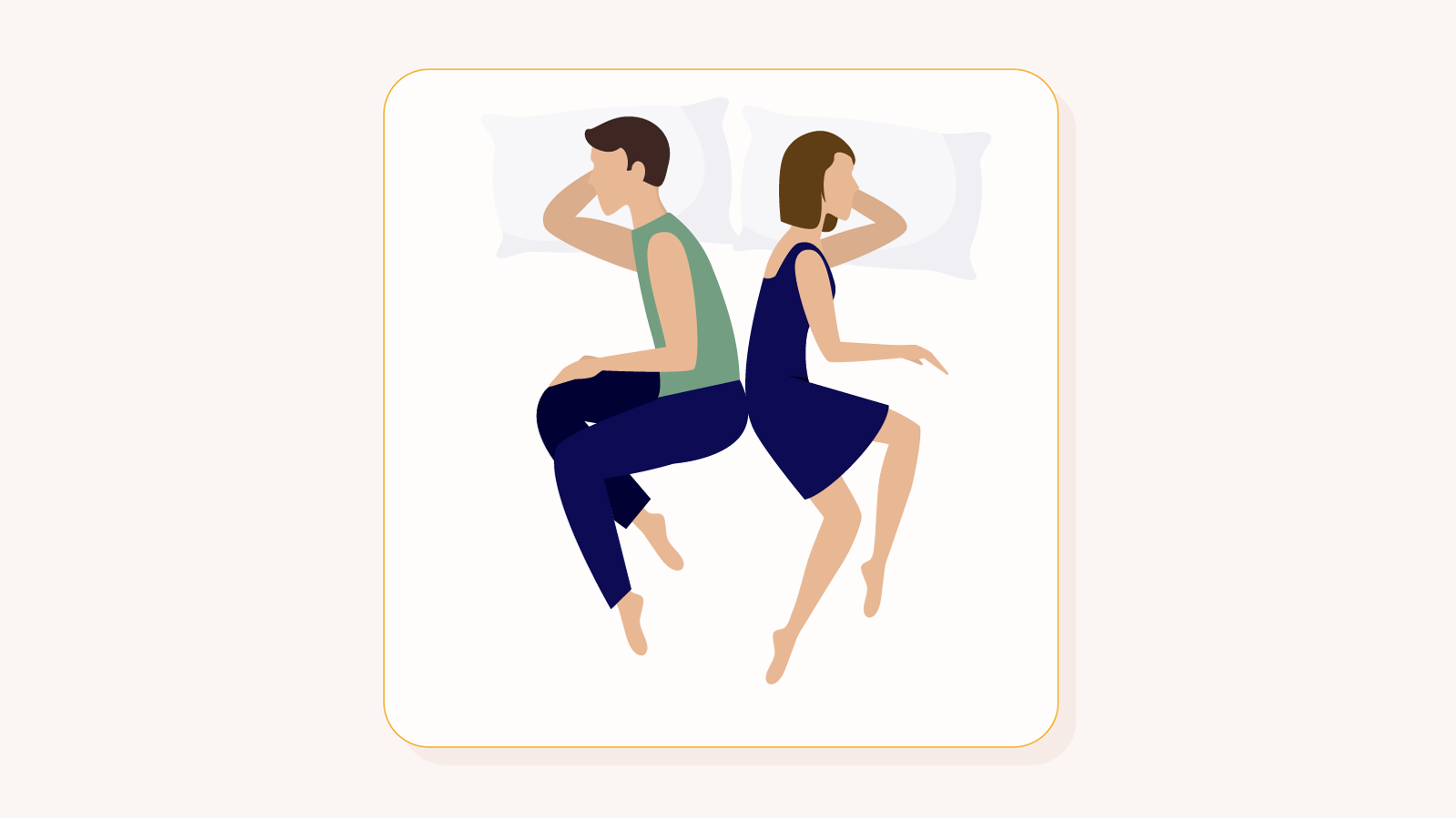
This position is perfect if you like your space—or prefer to sleep facing away from your partner—but still want that sense of physical closeness. In this position, you and your partner turn away from each other while lying on your sides. However, you’re lying in mirrored fetal positions, so your bottom is touching your partner’s.
Cuddling comfort tips:
- This position can be comfortable already since neither partner is constricted by the other. However, if you want to sleep more comfortably, both partners can have pillows to hug on their respective sides. This pushes you both to the centre of the bed and helps you remain in the same position throughout the night.
5. Leg Hug
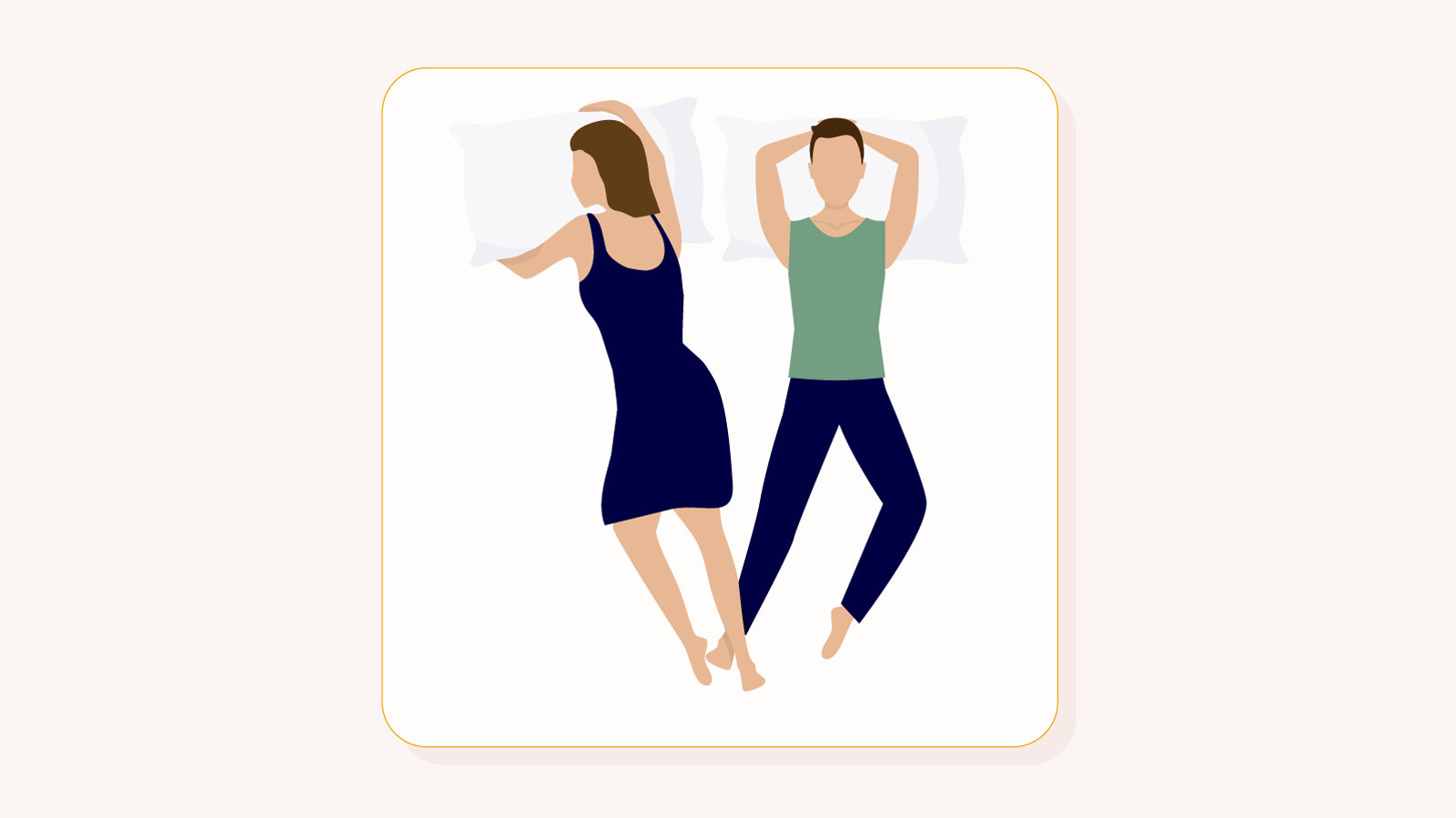
This position involves intertwining your legs with your partner’s while keeping the rest of your bodies apart. It’s ideal if you prefer light physical contact, or if you tend to overheat while cuddling.
Leg hugging is a versatile position since both you and your partner can keep your legs intertwined while you sleep in any position, whether it’s on your side, back or stomach. For example, your partner can lie on their back while you sleep on your stomach. As long as your legs are overlapping, you’re doing this position properly.
Cuddling comfort tips:
- Ensure your legs are comfortable supporting each other’s weight. Your partner’s legs could be too heavy for you to support for long periods of time. Any discomfort caused may not lead to the most restful sleep.
6. Holding Hands
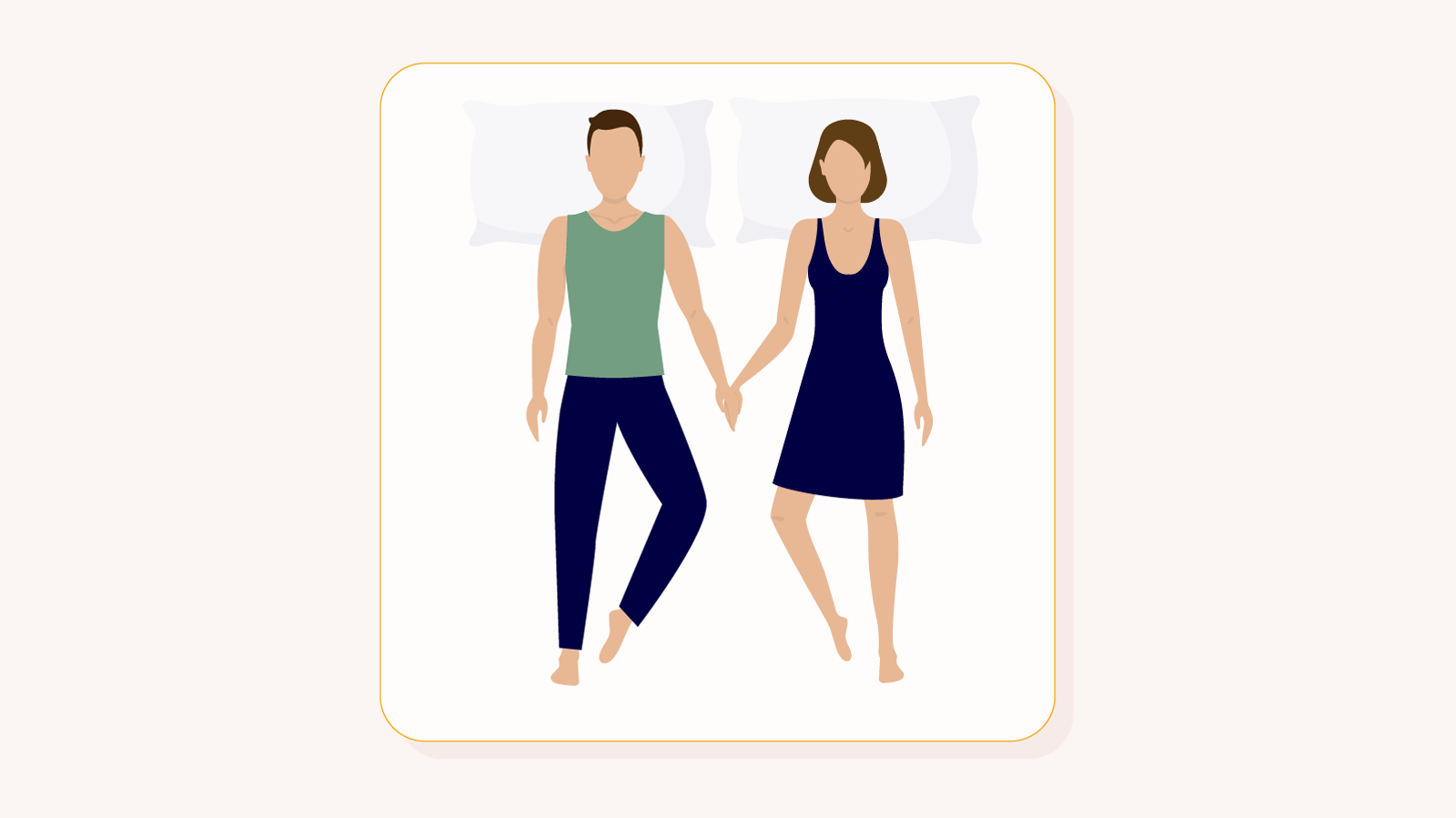
This position is an easy one. Similar to a leg hug, you can simply hold hands with your partner while individually lying in any comfortable position. As an example, your partner could be lying on their side with their arm extended toward you, while you hold their hand as you lie on your stomach.
Cuddling comfort tips:
- It helps to lie closer to each other while holding each other’s hands. That way, nobody has to overextend their arms, causing painful stretching overnight and arm pain in the morning.
7. Stacked Hug

Picture how you would hug your partner when standing, then rotate that picture 90 degrees. In this position, one partner lies on their back while the other lies directly on top of them, laying their head on their partner’s chest. The partner lying on their back can then pull the top-lying partner into a hug with both hands.
Cuddling comfort tips:
- Consider if there is a significant weight difference between you and your partner. The lighter partner should lie on top for a more comfortable rest. If you and your partner are similar in weight, this might be better as a naptime cuddling position rather than overnight.
- Experiment to see what feels comfortable. You can try using pillows propped up against the back-laying partner’s side. That way, if the partner on top starts to slide off, they can rest on the pillows and shift into a Half-Spoon position.
8. Head-On-Tummy

In this position, one partner lies on their back, while the other partner positions their body 90 degrees to the side. The sideways partner then rests their head on top of their partner’s tummy, using it as a pillow. The partner lying on their back can also hug their partner by holding their torso close to them.
Cuddling comfort tips:
- The sideways partner can lie in any position, as long as their head remains on the other partner’s torso. See whether it feels best to lie on your side, back, or stomach, and adjust as you need to.
- The partner lying on their back can have a lofty pillow underneath their legs to make their sleeping position feel more relaxed.
- To achieve this position, you may need a larger mattress size to ensure each partner can stretch out their whole body comfortably in opposite directions.
READ MORE: Get the complete guide to mattress sizes in Canada
9. The Loveseat
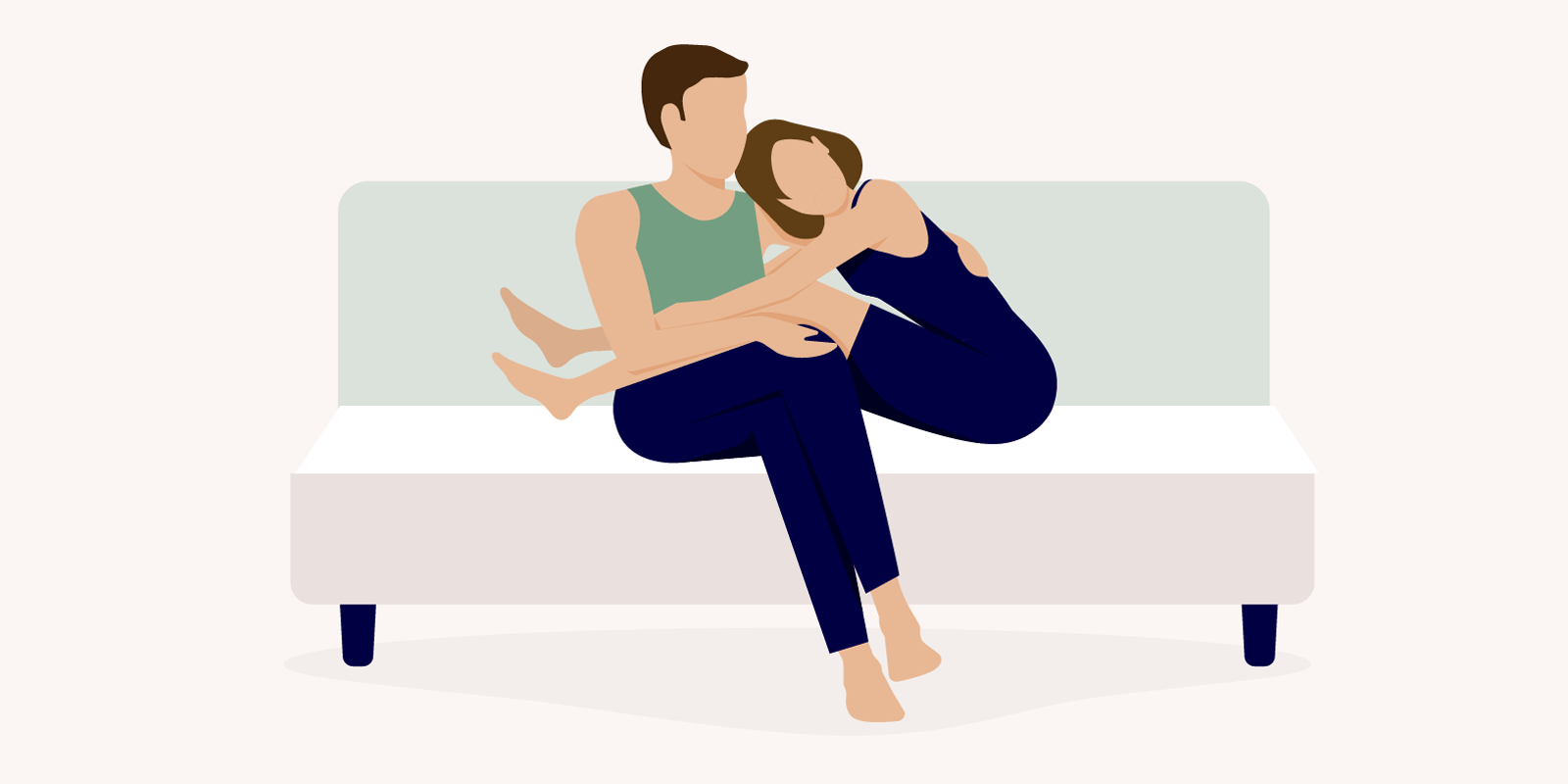
This position is perfect for when you’re lying on a couch with your partner. In this position, one person sits with both feet on the ground. The other person sits angled towards their partner, with their legs draped over their partner’s legs.
You can also hug your partner’s torso and lay your head against their shoulder. Your partner can cradle your back with one arm and hold your legs closer to their body so you don’t fall off the couch.
Cuddling comfort tips:
- The partner sitting upright can sit near the edge of the couch. That way, the couch hand supports the angled partner’s body.
- The upright partner can also put their legs on a footrest or a coffee table so the other person’s legs don’t slide off their lap.
10. Lap Pillow

This is another cuddling position that’s most comfortable when you’re lying on a couch with your partner. One partner sits upright on the couch with their feet on the floor. The other person lies down on the couch, either on their back or on their side, with their head on their partner’s lap.
Each partner can hug the other however they want. The person sitting up can also run their hands through their partner’s hair or massage their head for extra relaxation.
This is a casual cuddling position for when you and your partner are reading, watching TV, or enjoying each other’s company. It’s also an excellent position for the horizontal-lying person to nap.
Cuddling comfort tips:
- Try giving the horizontal-lying partner a pillow between their legs if they’re lying on their side, or under their knees if they’re lying on their back. This can be a great way to relieve any pressure or lower back pain.
- Consider switching positions with your partner the next time you try this position to allow them to take a comfortable nap, too.
Health Benefits of Cuddling
1. Improves Quality of Sleep
While sleeping with your loved one is a great way to show affection, it also has tangible benefits to your health and sleep quality. Cuddling up to people you love and trust and having tactile contact before sleep creates a sense of felt-security (a person’s internal sense of safety in relationships).
This helps create an environment where you feel safe and emotionally secure, leading to lower stress levels and helping you to fall asleep more easily (Xie and Feeney, 2024).
Research suggests that couples who are “sleep concordant” (i.e., who go to sleep and wake up at the same time) may feel their sleep quality is better. That’s because people rely on their partner for feelings of safety and security, which also translates to when you’re asleep with your partner (Taylor et al., 2019).
Cuddling an inanimate object like a pillow can also have a calming effect, similar to holding a partner. This can help you fall asleep and improve your sleep quality (Eckstein et al., 2020).
Increased feelings of relaxation due to the release of the hormone oxytocin can also affect how fast you fall asleep. If you suffer from sleep disorders such as insomnia, adding cuddling to your treatment plan may help relieve some symptoms and help you fall asleep faster.
2. Relieves Pain
Humans have evolved to find comfort in physical touch from their loved ones. Children are comforted when their parents give them physical affection, such as kissing their wounds or hugging them when they’re in physical pain or emotional distress.
Similarly, adults also find comfort in physical touch from their loved ones. Research suggests that skin-to-skin touch may have a pain-relieving effect, especially for those who experience chronic pain (Goldstein et al., 2018).
Another study found that simple touch and massage significantly improved pain management in cancer patients (Kutner et al., 2008).
Next time you go to bed, lightly massaging your partner’s body while cuddling can be a beneficial step to add to your routine, whether your partner is in physical pain or not.
3. Lowers Anxiety, Stress & Depression
Cuddling and positive physical touch can release oxytocin, the “love hormone.” Oxytocin has been shown to reduce anxiety and stress responses by reducing activity in the amygdala, the part of the brain that processes emotions such as fear and anxiety.
This promotes feelings of connection, pain relief, relation, and well-being, reducing depression and ultimately improving your sleep quality (Kerstin Uvnäs-Moberg et al., 2015).
Furthermore, social touches such as cuddling and massage can help reduce the stress hormone cortisol and increase mood-boosting hormones like dopamine and serotonin.
The combination of reduced stress hormones and increased “happy” hormones helps create feelings of long-lasting happiness and boosts overall well-being (Hernandez-Rei et al., 2004).
4. Lowers Blood Pressure
Physical touch, such as cuddling or hugging, helps to calm us down and acts as a buffer against stressful situations. According to research, tactile contact with people we trust activates the parasympathetic nervous system (i.e., the system that helps to calm and relax the body) (Games, 2022).
Stimulated relaxation in the body helps to slow down your heart rate and decrease blood pressure (Grewen et al., 2003). This is beneficial since high blood pressure is linked to heart-related complications such as strokes and heart disease.
So getting your cuddle time with your loved ones—whether that’s your partner or kids—can have real health benefits, especially if you struggle with high blood pressure.
5. Increases Body Temperature
If all those health benefits weren’t enough to convince you of the benefits of cuddling, there’s also the added bonus of feeling warm with skin-to-skin contact with your partner, especially on extra-cold nights.
This is great if you run cold while you sleep. You can regulate your own body temperature by cuddling up to your partner, and help yourself sleep more comfortably throughout the night.
Relationship Benefits of Cuddling
1. Builds Trust and Connection
We mentioned above that physical touch, whether through cuddling or more intimate means, releases a hormone called oxytocin. This promotes feelings of closeness and trust, helps reduce negative interactions, and lowers relationship-related stress.
This means physical touch with your partner is linked to overall relationship satisfaction. It can also improve your day-to-day interactions with your partner. If you and your partner are having trouble getting along lately, you might notice some improvement if you add extra cuddles to your day (Roberts et al., 2022).
Couples who cuddle after sex also feel more connected with each other, both emotionally and physically. Combined with the positive feelings of sexual satisfaction, this can help improve the quality of their relationship (Muise et al., 2014).
READ MORE: Check out our ranked list of the best mattresses for sex
2. Improves Mood After Conflict
The frequency of hugs you receive from your partner can determine how quickly you recover from interpersonal conflicts with them.
Research suggests that hugging your partner when conflict arises helps you feel better, not only on the day of conflict but also the days after. The emotional impact of conflict with your loved one is also lessened when you hug your partner.
Essentially, hugs act as a buffer for stress and other negative emotions. Physical touch like hugging and cuddling can act almost as a mediator when it comes to conflict, improving the health of your relationship (Murphy et al., 2018).
Frequently Asked Questions
What is cuddling?
Cuddling is the act of holding your partner and cradling them close to you by putting your arms around them to show your love and affection. You and your cuddle partner (whether that’s your romantic partner or your kids) can lie on a bed or sit on a couch during your cuddle session.
How often should you cuddle?
While there is no magic number for how often you should cuddle your partner, a good starting point is to cuddle as much as you can or at least a few times a week. That could mean a lengthy cuddle session or just a short hug before you fall asleep.
Health and relationship benefits from cuddling are more noticeable when you and your partner consistently show physical affection, especially non-sexual affection.
What is the best mattress for cuddling?
Douglas Summit is the best mattress for cuddling. This is based on our criteria of good edge support, high motion isolation, and a medium-firm feel that provides balanced comfort and support in every position.
Douglas Summit also earns this title thanks to its multiple cooling technologies to keep you and your partner comfortable, like cool-to-the-touch nanofibres and cooling gel foam that dissipates heat. Douglas comes with a 365-night sleep trial and a 20-year warranty—all for $1,299 for a queen size.
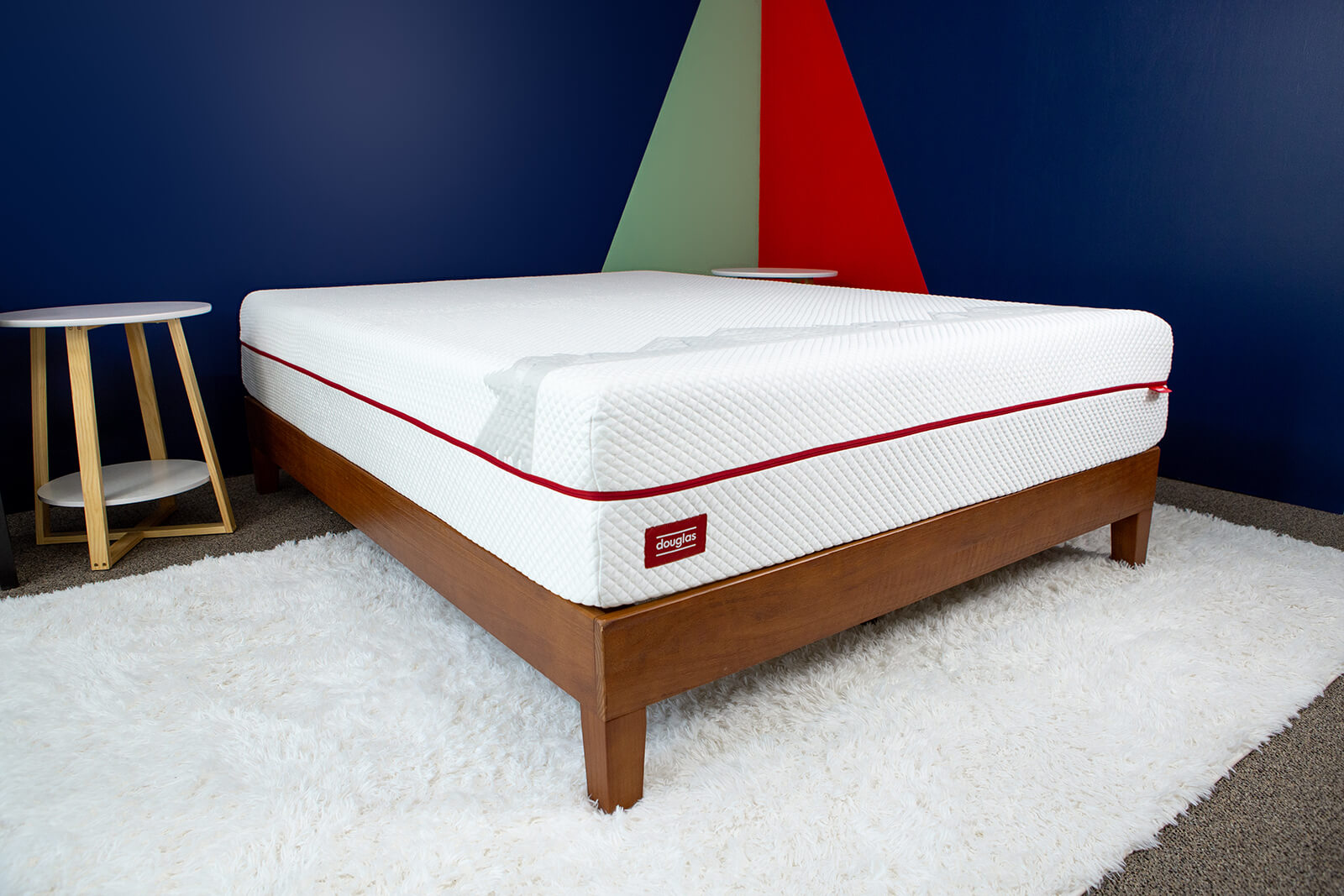
What is the best mattress for couples?
Douglas Original is ranked as the best mattress for couples, according to third-party engineer testing (commissioned by us). Douglas combines excellent edge support and motion isolation, targeted pressure-point relief, advanced cooling features, a 365-night at-home sleep trial, and a 20-year warranty—all for just $799 for a queen size.
(Want to make your sleep setup even more luxurious for you and your partner? Consider using soft, smooth, and ultra-breathable Egyptian Cotton sheets.)
What is the best mattress size for couples?
While queen-sized mattresses are the most common mattress size, some couples prefer a larger size, such as a king-size mattress. You and your partner must decide what is most essential in a mattress.
If you’re on a budget or working with a smaller space, consider a queen-size bed. If you have the square footage and plan to share your bed with your partner, kids, and pets, a king-size bed might be a better fit.
READ MORE: Queen vs king-size bed: which is right for you?
How to avoid overheating when you’re cuddling?
To avoid overheating while cuddling with your partner, choosing a mattress with cooling features (like Douglas Summit) can help. However, if you want to use your existing mattress, try tips like the ones below:
- Use bedding that’s great at regulating temperatures and creating a cool sleep environment, like cotton and bamboo sheets.
- Choose pillows that always have a cool side, such as cooling gel memory foam pillows.
- Wear light sleepwear made with silk or cotton for extra breathability.
- Turn on a fan or adjust your thermostat to 16–18°C (60–65°F) to help keep your room cool and comfortable.
Our goal is to provide the information you need to find the mattress that’s right for you. Get started with some of our most popular mattress shopping resources:
- Best Mattress Guides: Best Mattress Canada, Best Mattress In a Box
- Reviews: Douglas Original, Logan & Cove Choice, Juno, Octave Vista
- Comparisons: Douglas vs Endy, Douglas vs Casper
We use independent, third-party engineering firms (commissioned by us) with the APEGA stamp of approval to conduct mattress testing on our behalf, using publicly available data. We review and test all mattresses on 40+ criteria we think are important to you, including price, country of manufacture, sleep trial, warranty, features, materials used, motion isolation and edge support ratings, customer satisfaction reviews, returns, and refunds.
References:
- Yuxi Xie and Brooke C. Feeney. “A Narrative Review of Research Linking Non-Sexual Social Touch to Sleep Quality.” Journal of Sleep Research 33, no. 5 (February 2024): e14174. https://doi.org/10.1111/jsr.14174.
- Elsey, Taylor et al. “The role of couple sleep concordance in sleep quality: Attachment as a moderator of associations.” Journal of Sleep Research, vol. 28,5 (February 2019): e12825. https://doi:10.1111/jsr.12825.
- Monika Eckstein et al. “Calming Effects of Touch in Human, Animal, and Robotic Interaction-Scientific State-of-the-Art and Technical Advances.” Frontiers in Psychiatry, vol. 11 555058 (November 2020): https://doi:10.3389/fpsyt.2020.555058.
- Pavel Goldstein et al. “Brain-to-brain coupling during handholding is associated with pain reduction.” Proc. Natl. Acad. Sci. U.S.A.115 (11) E2528-E2537 (February 2018): https://doi.org/10.1073/pnas.1703643115.
- Jean S. Kutner et al. “Massage therapy versus simple touch to improve pain and mood in patients with advanced cancer: a randomized trial.” Annals of Internal Medicine, vol. 149 (6): 369-79 (September 2008): https://doi:10.7326/0003-4819-149-6-200809160-00003.
- Maria Hernandez-Rei et al. “Breast cancer patients have improved immune and neuroendocrine functions following massage therapy.”
Journal of Psychosomatic Research, vol. 57 (1) 45-52 (July 2004):
https://doi.org/10.1016/S0022-3999(03)00500-2. - Karen M. Grewen et al. “Warm partner contact is related to lower cardiovascular reactivity.” Behavioral medicine (Washington, D.C.), vol. 29 (3) 123-30 (Fall 2003): https://doi:10.1080/08964280309596065.
- Nicole A. Roberts et al. “Affective Experience and Regulation via Sleep, Touch, and “Sleep-Touch” Among Couples.” Affective Science, vol. 3 (2) 353-369. (February 2022): https://doi:10.1007/s42761-021-00093-3.
- Amy Muise et al. “Post Sex Affectionate Exchanges Promote Sexual and Relationship Satisfaction.” Archives of Sexual Behavior, vol 43 (7). (February 2014): https://doi:10.1007/s10508-014-0305-3.
- Micheal L. M. Murphy et al. “Receiving a hug is associated with the attenuation of negative mood that occurs on days with interpersonal conflict.” PLOS One, vol 13 (10). (October 2018): e0203522. https://doi.org/10.1371/journal.pone.0203522.
- Katelyn Games. “There’s a Reason Why You Want That Hug: The Science and Importance of Physical Contact.” MindBeacon A Kii Health Company. (August 2022): https://www.mindbeacon.com/strongerminds/the-science-and-importance-of-physical-contact.
- Kerstin Uvnäs-Moberg et al. “Self-soothing behaviours with particular reference to oxytocin release induced by non-noxious sensory stimulation.” Frontiers in Psychology, vol. 5 1529. (January 2015): https://doi:10.3389/fpsyg.2014.01529.
